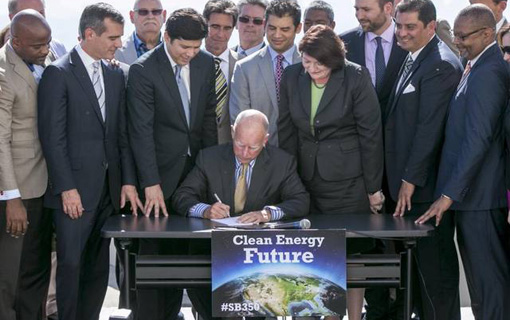
OAKLAND, Calif. – California’s groundbreaking initiatives are setting the pace, on multiple fronts, in the race to curb greenhouse gas emissions. But not without the vigorous and often vicious opposition of Big Oil companies and related corporate interests.
Aiming to encourage meaningful action among the world’s nations at the December United Nations Climate Change Conference in Paris, California is spearheading a global movement of subnational governments pledging to sharply slash greenhouse gas (GHG) emissions by 2050.
“We’re just getting warmed up,” said California Governor Jerry Brown, who helped launch this growing movement called Under 2 MOU, to which so far 43 states, provinces and major cities in 19 countries and five continents have become signatories.
Signatories to the MOU commit to either reduce GHG emissions 80 to 95 percent below 1990 levels by 2050 or achieve a per capita annual emission target of less than two metric tons by the same year.
The overall goal is to limit the rise in global temperature to below 2 Celsius – the warming threshold at which scientists say catastrophic climate disruptions will be likely.
Brown said agreements such as the Under 2 MOU, while voluntary, help “make sure the world takes the turn.”
At the same time, Glen Murray, Ontario’s environmental minister, told the Washington Post that “without the complexity of treaties” usually necessary to reach tangible agreements between nations, subnational governments are already “making commitments and supporting one another.”
For example,
- California’s power grid operator is helping Mexico set up its own independent grid-management body.
- Chinese officials, who are developing their own massive renewables program, have been consulting with California’s energy experts.
So, what accounts for the Golden State’s environmental prowess?
California is an economic powerhouse which, if it were a nation, would be rated eighth in the world just behind Brazil.
Then, as Brown has said, “It’s easy to say ‘de-carbonize,’ but to actually carry it out takes political will.”
And so it is.
Last week the Golden State upped the ante when Brown signed into law a bill, SB-350, requiring state-regulated utilities to increase by 50 percent the electricity generated from renewable energy sources, such as solar, wind and geothermal power, by 2030.
The bill also mandated a 50 percent increase in energy efficiency in buildings by the same year.
These were among a number of ambitious environmental initiatives the governor championed in his second term inaugural address in January.
Twenty six percent of California’s electrical power this year will come from clean sources like the sun and wind, without counting the large contribution from home solar generation. The national average is around 10 percent.
Previously California utilities had been required to provide 33 percent of their electricity from renewable sources by 2020. Contracts already in place are expected to guarantee the state reaches this goal.
The new law’s improved target of 50 percent within 15 years, while challenging, is realizable given the way things are going now, William Nelson, head of North American analysis at Bloomberg New Energy Finance, told the New York Times.
A robust solar panel installation and financing industry has emerged and is now expanding elsewhere in the country. Nearly 55,000 Californians are employed in solar.
California’s expertise and experience is likely to serve as a valuable resource, given President Obama’s Clean Power Plan requires every state to devise its own carbon emissions plan.
But more than cutting-edge high tech, entrepreneurial initiative and political will account for the Golden State’s lead.
It’s the balance of political power.
Unlike many states in the grip of the Republican rightwing, California is controlled by a Democratic governor and strong Democratic majorities in both legislative chambers, with a sizeable core of progressive legislators. All the state’s top elected officers are Democrats.
A combination of factors accounts for this, not least of which are a relatively strong labor movement and other progressive social movements, including racial, immigrant, gender, and LGBTQ rights, environmental, and anti-war organizations.
While this has not always been the case, at the base is a racially and ethnically diverse populace with an increasingly liberal and progressive bent along the coastal areas and in larger cities, where the bulk of the population is concentrated.
Still, powerful financial and corporate forces are arrayed against Californians, with Big Oil among its most reactionary.
The original version of SB-350 – cited by Brown in his inaugural remarks – included a mandate to cut the state’s consumption of petroleum by 50 percent by 2030.
After the Senate passed the original bill, 20 Assembly Democrats, constituting an informal conservative caucus, ganged up with the Republican minority to strip it of its petroleum mandate.
In the end, conservative Democrats joined with the majority to approve the other two parts of SB-350.
Senator President Pro tempore Kevin de Leon, author of the original bill, said, “I didn’t anticipate the tens of millions of dollars, the distortions” generated by oil companies in a massive advertising campaign.
A determined de Leon pledged to re-visit the fight over petroleum reduction use in the future.
Gov. Brown, who vowed to use his executive powers to cut petroleum consumption, declared, “I’d say the oil (industry) won a skirmish, but they’ve lost the bigger battle.”
Photo: Gov. Brown signs into law SB-350 at the Griffith Observatory in Los Angeles, California. | Damian Dovarganes/AP










